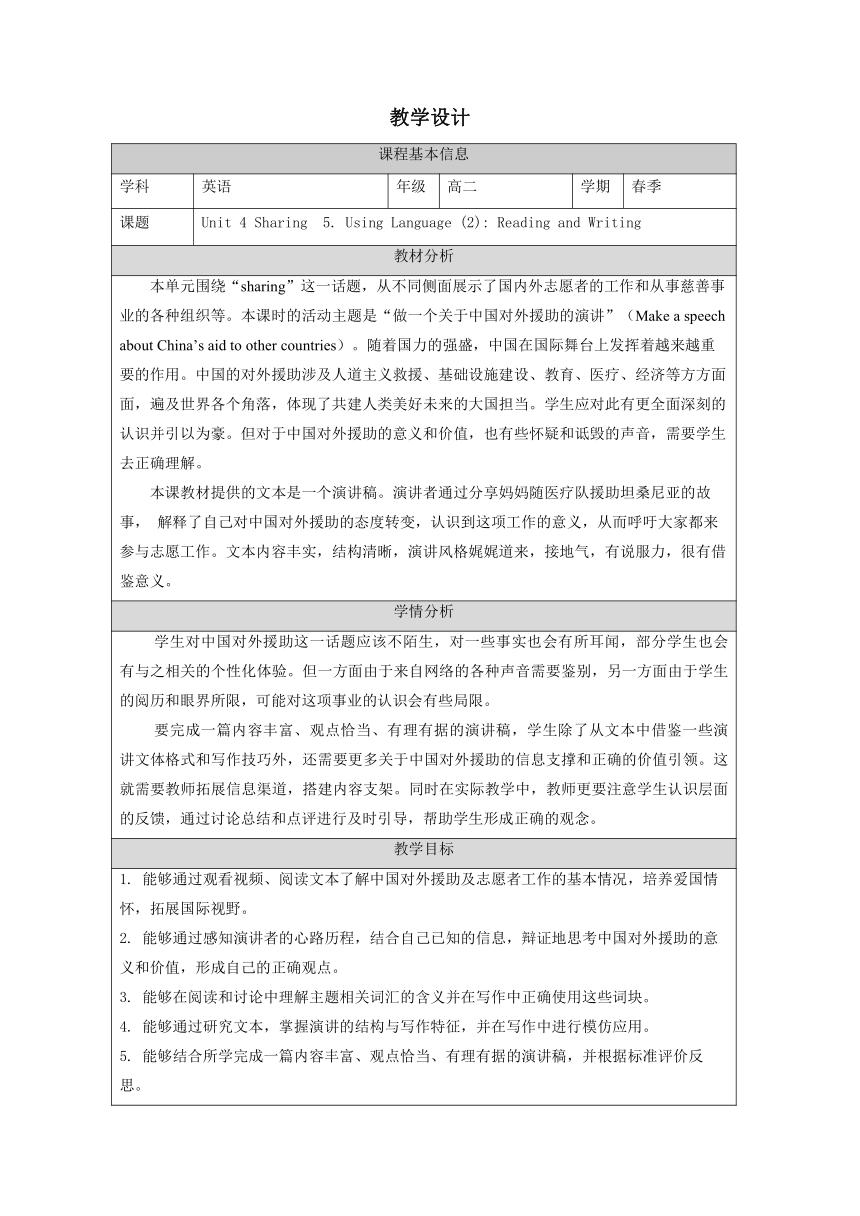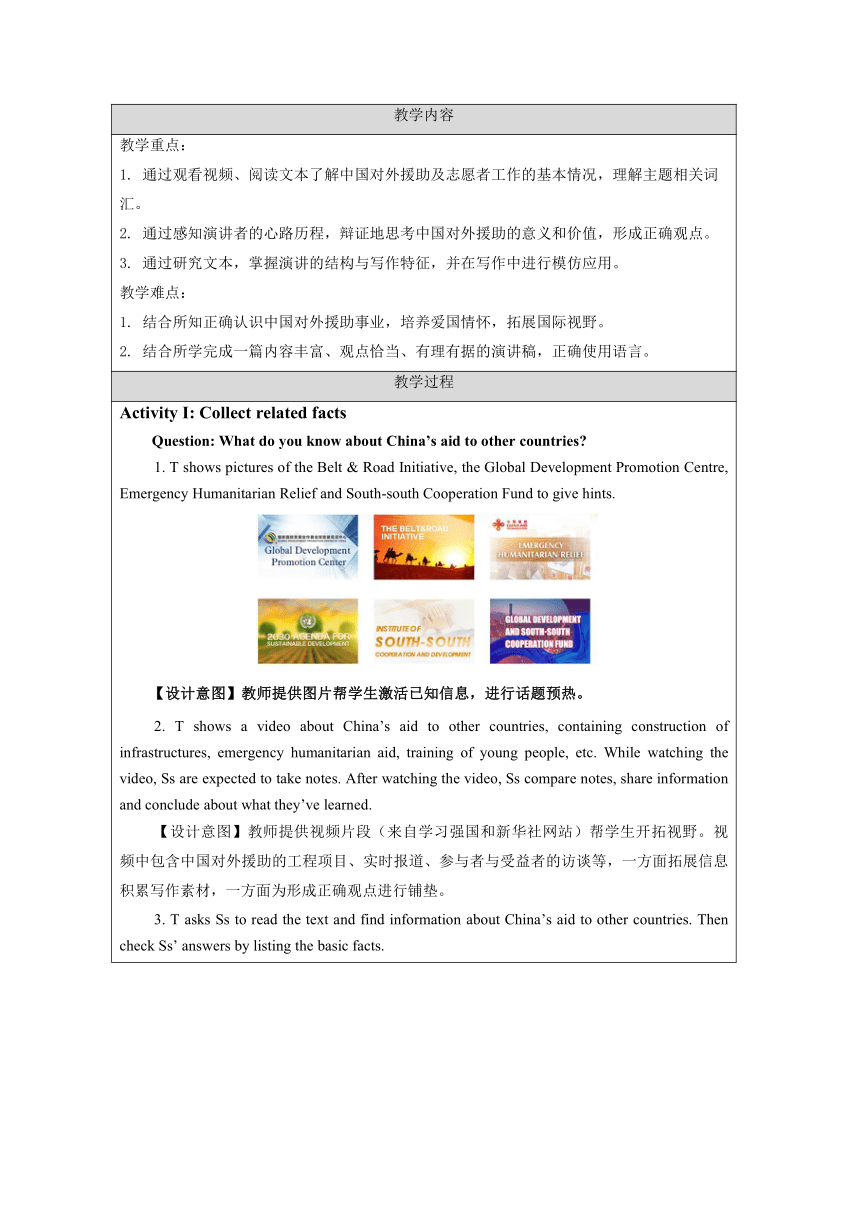人教版(2019)选择性必修第四册Unit4 Sharing Reading and Writing教学设计(表格式)
文档属性
| 名称 | 人教版(2019)选择性必修第四册Unit4 Sharing Reading and Writing教学设计(表格式) |

|
|
| 格式 | docx | ||
| 文件大小 | 1003.8KB | ||
| 资源类型 | 教案 | ||
| 版本资源 | 人教版(2019) | ||
| 科目 | 英语 | ||
| 更新时间 | 2024-04-19 09:16:22 | ||
图片预览


文档简介
教学设计
课程基本信息
学科 英语 年级 高二 学期 春季
课题 Unit 4 Sharing 5. Using Language (2): Reading and Writing
教材分析
本单元围绕“sharing”这一话题,从不同侧面展示了国内外志愿者的工作和从事慈善事业的各种组织等。本课时的活动主题是“做一个关于中国对外援助的演讲”(Make a speech about China’s aid to other countries)。随着国力的强盛,中国在国际舞台上发挥着越来越重要的作用。中国的对外援助涉及人道主义救援、基础设施建设、教育、医疗、经济等方方面面,遍及世界各个角落,体现了共建人类美好未来的大国担当。学生应对此有更全面深刻的认识并引以为豪。但对于中国对外援助的意义和价值,也有些怀疑和诋毁的声音,需要学生去正确理解。 本课教材提供的文本是一个演讲稿。演讲者通过分享妈妈随医疗队援助坦桑尼亚的故事, 解释了自己对中国对外援助的态度转变,认识到这项工作的意义,从而呼吁大家都来参与志愿工作。文本内容丰实,结构清晰,演讲风格娓娓道来,接地气,有说服力,很有借鉴意义。
学情分析
学生对中国对外援助这一话题应该不陌生,对一些事实也会有所耳闻,部分学生也会有与之相关的个性化体验。但一方面由于来自网络的各种声音需要鉴别,另一方面由于学生的阅历和眼界所限,可能对这项事业的认识会有些局限。 要完成一篇内容丰富、观点恰当、有理有据的演讲稿,学生除了从文本中借鉴一些演讲文体格式和写作技巧外,还需要更多关于中国对外援助的信息支撑和正确的价值引领。这就需要教师拓展信息渠道,搭建内容支架。同时在实际教学中,教师更要注意学生认识层面的反馈,通过讨论总结和点评进行及时引导,帮助学生形成正确的观念。
教学目标
1. 能够通过观看视频、阅读文本了解中国对外援助及志愿者工作的基本情况,培养爱国情怀,拓展国际视野。 2. 能够通过感知演讲者的心路历程,结合自己已知的信息,辩证地思考中国对外援助的意义和价值,形成自己的正确观点。 3. 能够在阅读和讨论中理解主题相关词汇的含义并在写作中正确使用这些词块。 4. 能够通过研究文本,掌握演讲的结构与写作特征,并在写作中进行模仿应用。 5. 能够结合所学完成一篇内容丰富、观点恰当、有理有据的演讲稿,并根据标准评价反思。
教学内容
教学重点: 1. 通过观看视频、阅读文本了解中国对外援助及志愿者工作的基本情况,理解主题相关词汇。 2. 通过感知演讲者的心路历程,辩证地思考中国对外援助的意义和价值,形成正确观点。
3. 通过研究文本,掌握演讲的结构与写作特征,并在写作中进行模仿应用。
教学难点: 1. 结合所知正确认识中国对外援助事业,培养爱国情怀,拓展国际视野。 2. 结合所学完成一篇内容丰富、观点恰当、有理有据的演讲稿,正确使用语言。
教学过程
Activity I: Collect related facts Question: What do you know about China’s aid to other countries 1. T shows pictures of the Belt & Road Initiative, the Global Development Promotion Centre, Emergency Humanitarian Relief and South-south Cooperation Fund to give hints. 【设计意图】教师提供图片帮学生激活已知信息,进行话题预热。 2. T shows a video about China’s aid to other countries, containing construction of infrastructures, emergency humanitarian aid, training of young people, etc. While watching the video, Ss are expected to take notes. After watching the video, Ss compare notes, share information and conclude about what they’ve learned. 【设计意图】教师提供视频片段(来自学习强国和新华社网站)帮学生开拓视野。视频中包含中国对外援助的工程项目、实时报道、参与者与受益者的访谈等,一方面拓展信息积累写作素材,一方面为形成正确观点进行铺垫。 3. T asks Ss to read the text and find information about China’s aid to other countries. Then check Ss’ answers by listing the basic facts. 【设计意图】教师让学生阅读文本梳理信息,并通过汇总学生的答案,将文本中的信息整理成两类:概况介绍和详细案例,帮助学生形成结构化的知识体系。通过结构化的文本解构,对比中国医疗队工作之前的状况和之后的效果,帮助学生感知援助工作的意义和价值,为形成正确的价值观念进一步铺垫。 Activity II: Form a sound opinion Question 1: What does the speaker think of China’s aid to other countries Question 2: What do you think of China’s aid to other countries T asks Ss to find out the speaker’s attitude towards the topic. By analyzing the speaker’s opinion, T encourages Ss to think about related topics and form their own opinions. 【设计意图】教师让学生梳理演讲者的观点,并从演讲者提供的案例中分析出中国对外援助对于受助者和志愿者双方面的意义和价值。同时,借助演讲者本身观点的变化历程,分析这位母亲从事志愿工作,对子女的衍生作用,即一方面帮助孩子拓展国际视野,另一方面使其思维模式从“self-centred”向“open-minded”转变。在此基础上,引导学生进一步思考话题相关内容,如是否对某项事业有个性化的理解和故事分享,以及如何为此事业贡献个人的力量等。通过小组讨论和观点收集,帮助学生积累素材,形成观点,为下一步写作任务做好铺垫。同时通过及时的点评,引导学生正确认识中国的对外援助事业。 Activity III: Study the writing features Question: How does the speaker convey his opinion T asks Ss to find out the structure and writing features of the given speech. By analyzing the text, Ss are expected to learn how to convey their opinions in the format of a speech and how to make their speeches both impressive and persuasive. 【设计意图】教师让学生梳理演讲的结构,总结演讲稿的写作特征,并从文中找出细节来支撑他们的观点。这篇演讲稿结构清晰,能够为学生的下一步写作提供很好的结构支架。同时,通过回归文本研读写作手法,学生能够赏析演讲稿的写作风格并在自己的写作中借鉴应用。教师还可以通过追问,拓展补充一些其他的常见演讲稿的修辞手法等,为学生的模仿和创作提供思路。 Activity IV: Draft and make a speech 1. T asks Ss to write their own speech about China's aid to other countries. Meanwhile, T provides a structure tip for reference and a checklist to help. 【设计意图】教师提供一个结构图式作为写作支架,给学生时间进行现场写作。另提供一个评价清单,帮学生进行写后的自评和互评。 2. T provides a possible version as follows for Ss to study and appreciate. Hello! My name is Li Hua. As is known, China has been taking an active part in helping people overseas. In the short term, China has donated all kinds of emergency humanitarian aid to those in need. While in the long run, China has been helping developing countries to improve the infrastructures and training young people to solve local problems. And people may ask, “Why bother ” I used to have the same question myself. To be honest, I had no idea where Zimbabwe is and what Zimbabwean life is like until I made a pen pal, Davies, who is studying medicine in Nanjing. In 2020, the outbreak of COVID-19 threatened our lives, causing a panic worldwide. Thanks to the wisdom and efforts of the medical experts, we Chinese could get vaccinated, protecting us from possible dangers effectively. While Davies and his family were not as lucky. He showed me a picture of his sister, holding her newborn baby, crying helplessly. Without proper treatment, all they could do was pray. It was right at that moment that I realized everyone deserves a fair chance in life. If you can reach a helping hand to someone in need, why not If you can make a difference to someone's life, why not So, when the news came that vaccines donated by China reached Zimbabwe and was distributed to common people, you can imagine the wild joy and gratitude of Davies. “It is like a ray of light from the end of the tunnel,” Davies said. Today, I want to relay to you that I'm proud of what our country has done. And I'm proud that we have both the ability and the willingness to help people overseas. “China aid for shared future” is not just a slogan, but a proposal as well as a position taken by China. Now that I understand how important China's aid is to other countries, I've decided to arm myself with academic knowledge and practical skills, so that one day I can shoulder my share of responsibilities for others. I pray that you'll do the same. Thank you! 【设计意图】教师提供一个范文供学生学习和欣赏。该范文模仿课文的结构,结合课堂所获信息和形成的观点,添加了个性化的故事和理解,应用了主题词汇和课上讨论过的修辞手法,对学生的写作生成进行了很好的示范。
作业布置
1. Required: Polish up your speech and present it in your class. 2. Optional: Find more speeches and study the writing features. Learn more about China's aid to other countries (http://en.cidca./). 【设计意图】作业按必做和选做两类分层布置,以关照到不同学生的水平和能力,对学有余力的学生进行课外自主学习进行有意的指导。
课程基本信息
学科 英语 年级 高二 学期 春季
课题 Unit 4 Sharing 5. Using Language (2): Reading and Writing
教材分析
本单元围绕“sharing”这一话题,从不同侧面展示了国内外志愿者的工作和从事慈善事业的各种组织等。本课时的活动主题是“做一个关于中国对外援助的演讲”(Make a speech about China’s aid to other countries)。随着国力的强盛,中国在国际舞台上发挥着越来越重要的作用。中国的对外援助涉及人道主义救援、基础设施建设、教育、医疗、经济等方方面面,遍及世界各个角落,体现了共建人类美好未来的大国担当。学生应对此有更全面深刻的认识并引以为豪。但对于中国对外援助的意义和价值,也有些怀疑和诋毁的声音,需要学生去正确理解。 本课教材提供的文本是一个演讲稿。演讲者通过分享妈妈随医疗队援助坦桑尼亚的故事, 解释了自己对中国对外援助的态度转变,认识到这项工作的意义,从而呼吁大家都来参与志愿工作。文本内容丰实,结构清晰,演讲风格娓娓道来,接地气,有说服力,很有借鉴意义。
学情分析
学生对中国对外援助这一话题应该不陌生,对一些事实也会有所耳闻,部分学生也会有与之相关的个性化体验。但一方面由于来自网络的各种声音需要鉴别,另一方面由于学生的阅历和眼界所限,可能对这项事业的认识会有些局限。 要完成一篇内容丰富、观点恰当、有理有据的演讲稿,学生除了从文本中借鉴一些演讲文体格式和写作技巧外,还需要更多关于中国对外援助的信息支撑和正确的价值引领。这就需要教师拓展信息渠道,搭建内容支架。同时在实际教学中,教师更要注意学生认识层面的反馈,通过讨论总结和点评进行及时引导,帮助学生形成正确的观念。
教学目标
1. 能够通过观看视频、阅读文本了解中国对外援助及志愿者工作的基本情况,培养爱国情怀,拓展国际视野。 2. 能够通过感知演讲者的心路历程,结合自己已知的信息,辩证地思考中国对外援助的意义和价值,形成自己的正确观点。 3. 能够在阅读和讨论中理解主题相关词汇的含义并在写作中正确使用这些词块。 4. 能够通过研究文本,掌握演讲的结构与写作特征,并在写作中进行模仿应用。 5. 能够结合所学完成一篇内容丰富、观点恰当、有理有据的演讲稿,并根据标准评价反思。
教学内容
教学重点: 1. 通过观看视频、阅读文本了解中国对外援助及志愿者工作的基本情况,理解主题相关词汇。 2. 通过感知演讲者的心路历程,辩证地思考中国对外援助的意义和价值,形成正确观点。
3. 通过研究文本,掌握演讲的结构与写作特征,并在写作中进行模仿应用。
教学难点: 1. 结合所知正确认识中国对外援助事业,培养爱国情怀,拓展国际视野。 2. 结合所学完成一篇内容丰富、观点恰当、有理有据的演讲稿,正确使用语言。
教学过程
Activity I: Collect related facts Question: What do you know about China’s aid to other countries 1. T shows pictures of the Belt & Road Initiative, the Global Development Promotion Centre, Emergency Humanitarian Relief and South-south Cooperation Fund to give hints. 【设计意图】教师提供图片帮学生激活已知信息,进行话题预热。 2. T shows a video about China’s aid to other countries, containing construction of infrastructures, emergency humanitarian aid, training of young people, etc. While watching the video, Ss are expected to take notes. After watching the video, Ss compare notes, share information and conclude about what they’ve learned. 【设计意图】教师提供视频片段(来自学习强国和新华社网站)帮学生开拓视野。视频中包含中国对外援助的工程项目、实时报道、参与者与受益者的访谈等,一方面拓展信息积累写作素材,一方面为形成正确观点进行铺垫。 3. T asks Ss to read the text and find information about China’s aid to other countries. Then check Ss’ answers by listing the basic facts. 【设计意图】教师让学生阅读文本梳理信息,并通过汇总学生的答案,将文本中的信息整理成两类:概况介绍和详细案例,帮助学生形成结构化的知识体系。通过结构化的文本解构,对比中国医疗队工作之前的状况和之后的效果,帮助学生感知援助工作的意义和价值,为形成正确的价值观念进一步铺垫。 Activity II: Form a sound opinion Question 1: What does the speaker think of China’s aid to other countries Question 2: What do you think of China’s aid to other countries T asks Ss to find out the speaker’s attitude towards the topic. By analyzing the speaker’s opinion, T encourages Ss to think about related topics and form their own opinions. 【设计意图】教师让学生梳理演讲者的观点,并从演讲者提供的案例中分析出中国对外援助对于受助者和志愿者双方面的意义和价值。同时,借助演讲者本身观点的变化历程,分析这位母亲从事志愿工作,对子女的衍生作用,即一方面帮助孩子拓展国际视野,另一方面使其思维模式从“self-centred”向“open-minded”转变。在此基础上,引导学生进一步思考话题相关内容,如是否对某项事业有个性化的理解和故事分享,以及如何为此事业贡献个人的力量等。通过小组讨论和观点收集,帮助学生积累素材,形成观点,为下一步写作任务做好铺垫。同时通过及时的点评,引导学生正确认识中国的对外援助事业。 Activity III: Study the writing features Question: How does the speaker convey his opinion T asks Ss to find out the structure and writing features of the given speech. By analyzing the text, Ss are expected to learn how to convey their opinions in the format of a speech and how to make their speeches both impressive and persuasive. 【设计意图】教师让学生梳理演讲的结构,总结演讲稿的写作特征,并从文中找出细节来支撑他们的观点。这篇演讲稿结构清晰,能够为学生的下一步写作提供很好的结构支架。同时,通过回归文本研读写作手法,学生能够赏析演讲稿的写作风格并在自己的写作中借鉴应用。教师还可以通过追问,拓展补充一些其他的常见演讲稿的修辞手法等,为学生的模仿和创作提供思路。 Activity IV: Draft and make a speech 1. T asks Ss to write their own speech about China's aid to other countries. Meanwhile, T provides a structure tip for reference and a checklist to help. 【设计意图】教师提供一个结构图式作为写作支架,给学生时间进行现场写作。另提供一个评价清单,帮学生进行写后的自评和互评。 2. T provides a possible version as follows for Ss to study and appreciate. Hello! My name is Li Hua. As is known, China has been taking an active part in helping people overseas. In the short term, China has donated all kinds of emergency humanitarian aid to those in need. While in the long run, China has been helping developing countries to improve the infrastructures and training young people to solve local problems. And people may ask, “Why bother ” I used to have the same question myself. To be honest, I had no idea where Zimbabwe is and what Zimbabwean life is like until I made a pen pal, Davies, who is studying medicine in Nanjing. In 2020, the outbreak of COVID-19 threatened our lives, causing a panic worldwide. Thanks to the wisdom and efforts of the medical experts, we Chinese could get vaccinated, protecting us from possible dangers effectively. While Davies and his family were not as lucky. He showed me a picture of his sister, holding her newborn baby, crying helplessly. Without proper treatment, all they could do was pray. It was right at that moment that I realized everyone deserves a fair chance in life. If you can reach a helping hand to someone in need, why not If you can make a difference to someone's life, why not So, when the news came that vaccines donated by China reached Zimbabwe and was distributed to common people, you can imagine the wild joy and gratitude of Davies. “It is like a ray of light from the end of the tunnel,” Davies said. Today, I want to relay to you that I'm proud of what our country has done. And I'm proud that we have both the ability and the willingness to help people overseas. “China aid for shared future” is not just a slogan, but a proposal as well as a position taken by China. Now that I understand how important China's aid is to other countries, I've decided to arm myself with academic knowledge and practical skills, so that one day I can shoulder my share of responsibilities for others. I pray that you'll do the same. Thank you! 【设计意图】教师提供一个范文供学生学习和欣赏。该范文模仿课文的结构,结合课堂所获信息和形成的观点,添加了个性化的故事和理解,应用了主题词汇和课上讨论过的修辞手法,对学生的写作生成进行了很好的示范。
作业布置
1. Required: Polish up your speech and present it in your class. 2. Optional: Find more speeches and study the writing features. Learn more about China's aid to other countries (http://en.cidca./). 【设计意图】作业按必做和选做两类分层布置,以关照到不同学生的水平和能力,对学有余力的学生进行课外自主学习进行有意的指导。
